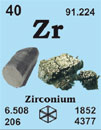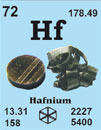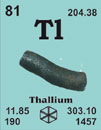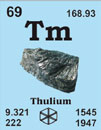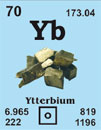Palladium 46Pd106.4
Discovered in 1803 by W.H. Wollaston at London, England.
[Named after the asteroid Pallas]
French: palladium
German: Palladium
Italian: palladio
Spanish: palladio
Description: Palladium is a lustrous, silvery-white, malleable and ductile metal of the so-called platinum group. It resists corrosion, but dissolves in oxidising acids and in molten alkalis. Palladium metal has the unusual ability of allowing hydrogen gas to filter through it. It is mailny used as a catalyst.
Palladium single crystal properties
| State: |
single crystal |
|---|
| Crystal structure: |
fcc |
|---|
| Production method: |
Czochralski |
|---|
| Standard size: |
diameter 6-12mm
thickness 1-2mm |
|---|
| Orientation: |
(100), (110) and (111) |
|---|
| Orientation accuracy: |
<2°, <1°, <0.4° or <0.1° |
|---|
| Polishing: |
as cut, one or two sides polished |
|---|
| Roughness of surface: |
<0.03µm |
|---|
| Purity: |
99.999% |
|---|
| Typical analysis (ppm): |
C 3
H < 1
O 9
N < 5
Cu 1.60
Fe 1.80
Ni < 1
Pb 0.30
Si 0.30
Ga, Hf and Ta are below the detection limit
|
|---|
Materials properties
| Density: |
12.0 g/cm3 |
|---|
| Melting point: |
1551.85 °C / 1825 °K |
|---|
| Boiling point: |
3139.85 °C / 3413 °K |
|---|
| Molar volume: |
8.85 cm3 |
|---|
| Thermal conductivity: |
71.8 [300 K] Wm-1K-1 |
|---|
| Coefficient of linear thermal expansion: |
11.2 x 10-6 K-1 |
|---|
| Electrical resistivity: |
10.8x 10-8 [293 K] Wm |
|---|
| Mass magnetic susceptibility: |
+6.702 x 10-8(s) kg-1m3 |
|---|
| Young's modulus: |
121 GPa |
|---|
| Rigidity modulus: |
43.6 GPa |
|---|
| Bulk modulus: |
187 GPa |
|---|
| Poisson's ratio: |
0.39 |
|---|
| Radii: |
Pd4+ 64; Pd2+ 86; atomic 138; covalent 128 |
|---|
| Electronegativity: |
2.20 (Pauling); 1.35 (Allred); 4.45 eV (absolute) |
|---|
| Effective nuclear charge: |
4.05 (Slater); 7.84 (Clementi); 11.11 (Froese-Fischer) |
|---|
| Number of Isotopes (incl. nuclear isomers): |
25 |
|---|
| Issotope mass range: |
96 -> 116 |
|---|
| Crystal structure, (cell dimentions / pm), space group |
fcc |
|---|
| X-ray diffraction: mass absorption coefficients: |
CuKα 206 (µ/r) / cm2g-1
MoKα 24.1 (µ/r) / cm2g-1 |
|---|
| Neutron scattering length: |
0.591 b/10-12 cm |
|---|
| Thermal neutron capture cross-section: |
6.9 sa / barns |
|---|
Biological data
| Biological role: |
none |
|---|
| Toxicity |
|
|---|
| Toxic intake: |
n.a. |
|---|
| Lethal intake: |
LD50 (chloride, oral, rat)25 = mg kg-1 |
|---|
| Hazards: |
Palladium is poorly absorbed by the body when ingested and PdCl2 was formerly presribed as a treatment for tuberculosis at the rate of 65 mg per day (approximately 1 mg kg-1 without apparent ill effec |
|---|
| Level in humans |
|
|---|
| Blood: |
|
|---|
| Bone: |
|
|---|
| Liver: |
|
|---|
| Muscle: |
|
|---|
| Daily dietary intake: |
n.a. |
|---|
| Total mass of element in average [70 kg] person: |
n.a. |
|---|
Geological data
| Mineral | Formula | Density | Hardness | Crystal apperance |
|---|
| Palladium |
Pd |
11.9 |
4.5 - 5 |
cub. met. white/grey |
|---|
| Chief ore: |
speciments of the native metal are found in Brazil. Most is extracted as a by-product from copper an |
|---|
| World production: |
24 tonnes/year |
|---|
| Main mining areas: |
see copper and zinc |
|---|
| Reserves: |
24 000 tonnes |
|---|
| Specimen: |
available as foil, granules, powder, rod, shot sponge or wire. Safe. |
|---|
| Abundances |
|
|---|
| Sun: |
32 (relative to H = 1 x 1012) |
|---|
| Earth's crust: |
c. 6 x 10-4 p.p.m. |
|---|
| Seawater: |
|
|---|
| Residence time: |
|
|---|
| Classification: |
recycled |
|---|
| Oxidation state: |
II |
|---|
Source: Emsley, J. (1998) The Elements (3rd Edition)

 English
English
 Deutsch
Deutsch








































